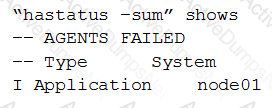Veritas VCS-260 Administration of Veritas InfoScale Availability 7.3 for UNIX/Linux Exam Practice Test
Administration of Veritas InfoScale Availability 7.3 for UNIX/Linux Questions and Answers
Which two requirements must be met to allow an administrator to configure LLT heartbeats over UDP? (Choose two.)
An administrator is bringing a service group online. One of the resources is remaining offline, and is shown in ‘waiting to go online’ state.
Which command should the administrator run to stop Veritas Cluster Server from attempting to bring the resource online to troubleshoot the issue?
Which resource type can an administrator use to mirror the state of another persistent resource?
Which Veritas Cluster Server command should be used to change OnlineRetryLimit for all Mount resources?
An administrator receives the following message:

Which command should the administrator run to recover from the failure?
Which two actions must an administrator take to upgrade an application under cluster control? (Choose two.)
Which service group dependency type supports two applications being online on any system in the cluster?
Which requirements must an administrator meet prior to implementing an InfoScale Availability cluster that includes both physical and virtual machines?
An administrator is notified that a service group faulted due to a disk group failure.
Which two Veritas Cluster Server logs can the administrator review to determine the reason for the failure? (Choose two.)
What is the purpose of the Steward process in a global cluster?
Veritas Cluster Server supports the Intelligent Monitoring Framework (IMF) which assists clustered environments by reducing polling overhead and failure detection times.
Which two agents are IMF aware? (Choose two.)
What is the role of the AWSIP agent in an Amazon Web Services (AWS) cloud environment?
